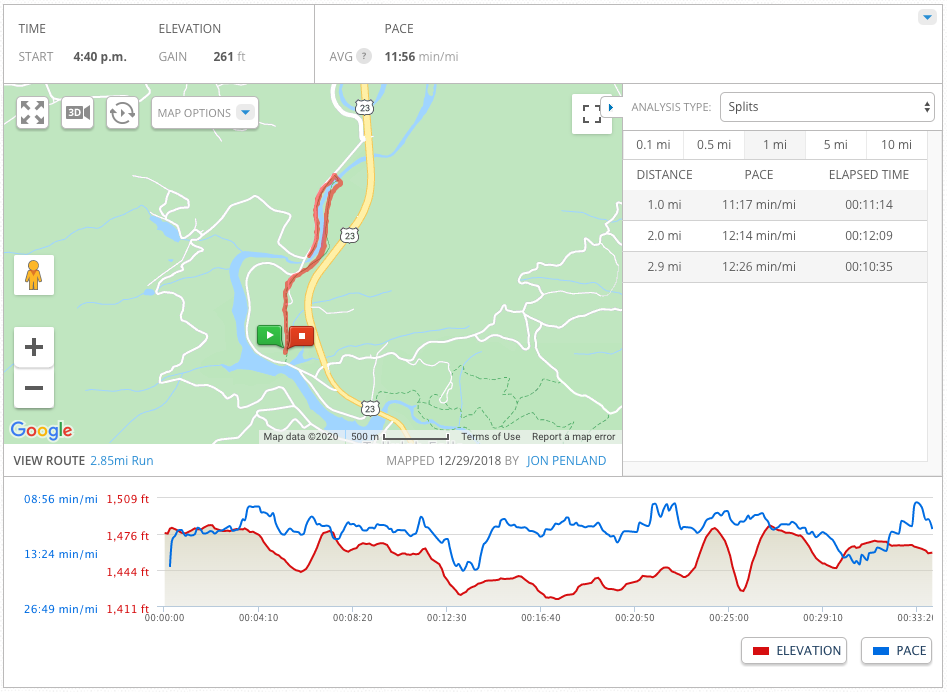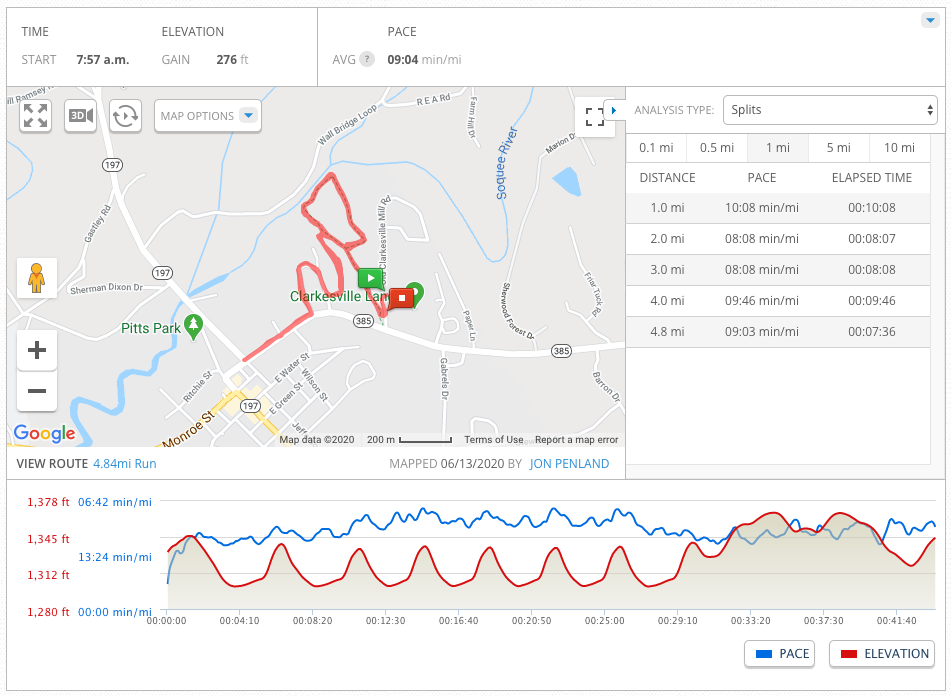I made my first foray back into running in December 2018. Due to a long history of overuse injuries, I started very, very slowly.
Here’s what my first run looked like back on December 29, 2018.

Since then, my running strategy over the last 18 months has revolved around two priorities.
- Don’t get hurt.
- Slowly increase mileage, but don’t push pace. Run at a conversational pace.
I’ve been able to do those two things. Here I am, 18 months later, and my most recent runs have been approaching the 8 mile mark. I’ve been able to increase the length of my runs quite a bit while managing to avoid injury.
I’ve said it on this blog before, but I’ll say it again: it’s nothing short of amazing to me that I can run 7-8 miles once a week without injury.
It’s Time for a Change
I’ve been feeling the desire to start imposing some additional structure on my running. My current structure is this: run once per week, run slow, run as far as you can before you hit exhaustion. I think I’ve taken that structure about as far as I can.
I’m still very, very concerned about injury.
This desire to add some structure to my running while avoiding injury lead me to pick up the book Run Less Run Faster by Bill Pierce, Scott Murr, and Ray Moss.
I’ll write more about the book once I’ve finished it, but the basic premise behind the book can be summarized as follows:
- Most runners run a lot of “junk” miles: lots of slow miles that do little to nothing to spur the physiological changes that help runners improve.
- Most runners run too often and don’t give their joints and muscles enough days off to recover.
- 3 quality runs per week paired with 2 non-weight-bearing cardio workouts (swim, cycle, or row) give runners the right combination of exercise to spur improvement while minimizing the risk of injury.
Laying the Foundation
I’m not ready to jump into the program. There are three variables you have to think about when it comes to modifying a running program:
- Frequency: how often you run
- Duration: how long or far you run
- Intensity: how hard you run
You should only modify on variable at a time.
I’ve been running once per week, totally about 7 miles per week, and running with very low intensity. If I were to jump into the program–even the 5K Intermediate Training Program–I’d be modifying all three variables at the same time.
- I’d be increasing my frequency from 1 to 3 runs per week.
- Duration would be increasing modestly, as the program calls for about 10 miles per week to begin with and I’ve only been running about 7 miles per week.
- I’d be pushing intensity from a 4 or 5 out of 10 to a 9 out of 10.
I feel that jumping straight in with both feet would almost certainly result in an overuse injury.
A Gradual Ramping Up Period
Jumping right in is no good, so I need to ramp up slowly. Here’s my plan:
Step 1: Trim distance but increase intensity.
My thinking here is that the biggest change I need to make is to stop logging only “junk miles” and add some quality miles into my runs. So the first change I’m going to make is shorten my weekly runs and add some pace variation.
So rather than run 7 miles, perhaps I’ll run 4-5 miles where 2-3 of those files are run at a higher intensity (about 30 seconds per mile slower than the 5k race pace).
I’ll do this for at least 3 weeks (but possibly longer) before moving on to Step 2.
Step 2: Add in the track repeats.
The program prescribed in the book includes three types of runs: track repeats, a tempo run, and a long run.
Step 1 will effectively align what I’m already doing with the book’s concept of a long run. Step 2 will add in the track repeats.
Logistically speaking, track repeats should be an easy workout to add because I can use the road in front of my house for this workout. I’ve already measured off 400 meters, which is the distance needed for these workouts.
I’ll add track repeats to my weekly program for at least 3 weeks (but possibly longer) before moving on to Step 3.
Step 3: Add in the tempo run.
The tempo run is a shorter run than the long run, but at higher intensity. An example of a tempo run during the 5K Intermediate Program is to run 1 mile nice and easy, 1 mile at a hard pace (just shy of 5K race pace), and finish up with a third easy mile.
I haven’t planned beyond that point. It should take me about 3 months to get to the point that I’m running 3x per week. My distance at that point should be comparable, if slightly more, than I’m running right now, but I will have gradually increased both intensity and frequency.
Once I get to that point I should be prepared to embark on the 5K Intermediate Training Program in earnest.
Run Log
Today I made my first attempt at converting my weekly lazy run into the long run described in Run Less Run Fast.
Rather than run 7 or 8 miles, I ran just shy of 5 miles. Rather than run at an average page over 10 minutes per mile, my average pace was 9:04 per mile.
My plan was the following:
- One easy mile at 10-10:30.
- Three miles run at a pace between 8:40-8:45 per mile.
- One easy mile at 10-10:30.
As it turns out, I have no idea how to pace myself.
I started out perfectly. My first mile was very comfortable and clocked in at 10:08. I gradually increased my pace and at the one mile mark I dug in at a much faster clip.
Unfortunately, I was afraid of running too slow and, as a result, ended up running two fast. Mile two clocked in at 8:08. That’s actually faster than the pace I ran at my last 5k in September 2019 (8:13 / mile).
I could tell I was going too fast so I tried to slow down a bit. Then I started to fatigue, which made me worry that I was slowing down too much, so I pressed on.
It was at that point, about 1.5 miles into the hard portion of the run, that I realized I’d overdone it. Could I keep up this pace for another mile and a half? Yes, but if I did I’d be running a much more intense run that I’d meant to run–a much more intense run that I was comfortable with.
Mile three, the second hard mile, clocked in at 8:08 again.
At that point I decided I needed to consider 2 fast miles (fast for me anyway) to be enough fast miles for one day. I ran another 1.8 easy miles at a pace ranging between 9-10 minutes per mile.

So this first round wasn’t a rousing success. I haven’t thought about pace in a really long time and I’ve completely lost my ability to judge pace and intensity. It’s going to take some time to regain the ability to accurately just intensity and pace.
I am pretty pleased with the overall result. It was encouraging to clock two miles at just over an 8 minute pace. I haven’t run at that sort of speed since my last 5k way back in September 2019. It was nice to see that I’ve actually improved by a modest margin since then despite never running at a pace faster than about 9 minutes per mile.
I’d rate today’s run a 6 or 7 out of 10. It wasn’t as fun as my nice lazy runs and I didn’t pace myself well. However, it was still encouraging to see that there is a foundation there for me to build on.
Featured image by Jenny Hill on Unsplash
